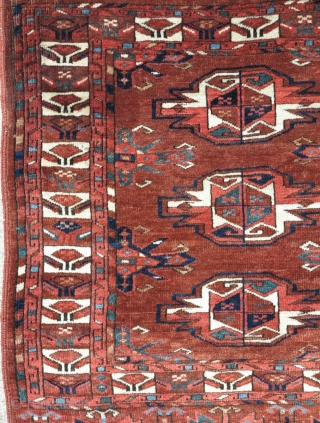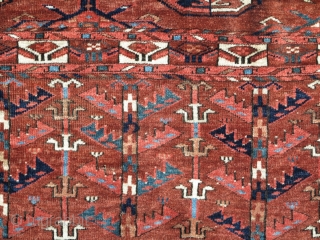"Yomut Family Juval 72x125 (2'6"x4'1") early 19th century.
This juval belongs to a small cluster of early pieces with the AsR knot. The gul usually has a one-colour bird bracket (not in this example).vThe second design layer is missing th horizontal triangles and there are no rectangles in the diagonal axis. The secondary gul is usually the early version of the chemche gul shown here. The main border here has the flower in the box motif sometimes with the later version shown in plate 26. The sarkhala minor border has a barber pole guard stripe on its outside. In the earliest examples, this additional stripe is found outside the minor border only. This cluster has both common features and differences with the Eagle Gul Group 2 juvals.
The shift from the squashed gulli to the tauk noska gols in the Pseudo Chodor carpets is reflected in this cluster with a shift from the one to the two-colour bird bracket. In plate 35 this shift occurred earlier than the shift to the later version of the flower in a box border. In other examples of this cluster, the order is reversed.
The changes in design continue (see plate 36) with changes in the gul and the disappearance of the flower in the box and the sarkhala borders. This early version of the chemche gul also disappears and it becomes hard to find common design features between this cluster and later juvals with the AsR knot.
The shift from the flower in a box and sharkhala borders also occurred in juvals that are symmetrically knotted.
Knot: AsR 39x78=3042 kn/dm (square). Colours (8): brown, red, dark blue, light blue, green, yellow, ivory, black."
- Home
- Antique Rugs by Region
- Category
- Profiles
- Post Items Free
- Albums
- Benaki Museum of Islamic Art
- Budapest: Ottoman Carpets
- Gulbenkian Museum
- Islamic Carpets. Brooklyn
- Islamic Textiles. Brooklyn
- Konya Museum: Rugs
- MKG, Hamburg
- MMA: Caucasian Carpets
- MMA: Mamluk Carpets
- MMA: Mughal Indian Carpets
- MMA: Ottoman Carpets
- MMA: Safavid Persian Carpets
- MMA: Turkmen Rugs
- McCoy Jones Kilims
- Ottoman textiles. Met
- Philadelphia Museum
- Rugs and Carpets: Berlin
- Seljuqs at the Met
- TIEM, Istanbul: Carpets
- V&A: Classical Carpets
- Vakiflar Carpets: Istanbul
- Baluch Rugs: Indianapolis
- Gallery Exhibitions
- Jaf an Exhibition
- Alberto Levi Gallery
- Andean Textile
- Christie's London: 2016
- Francesca Galloway
- HALI at 40
- ICOC Washington, DC 2018
- Jajims of the Shahsavan
- London Islamic Week April, 2018
- Mongolian Felts
- Navajo Rugs: JB Moore
- Persian Piled Weavings
- SF Tribal & Textile Art Show 2020
- SF Tribal 2019
- Sotheby's: C. Alexander
- Turkish Prayer Rugs
- Turkmen Main Carpets ICOC 2007











